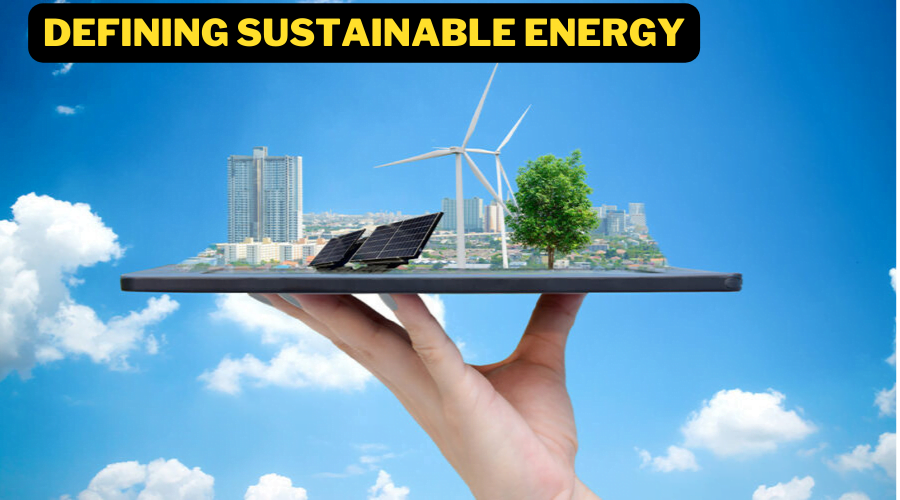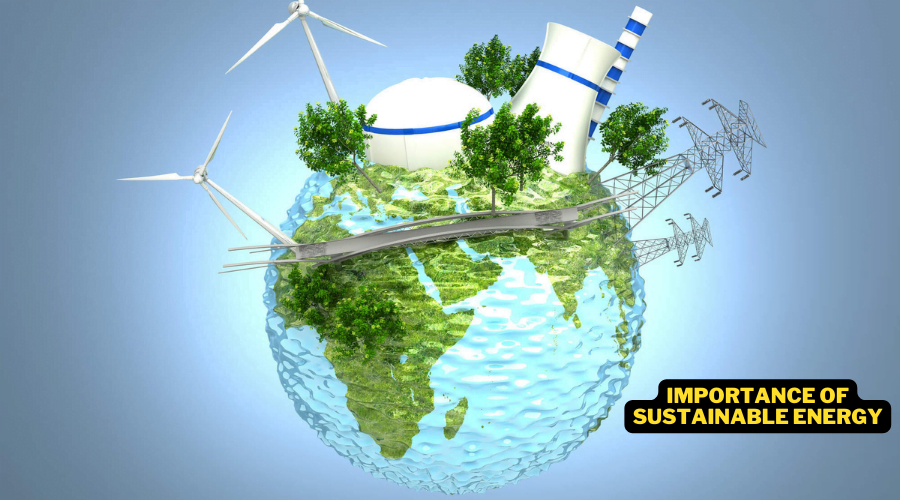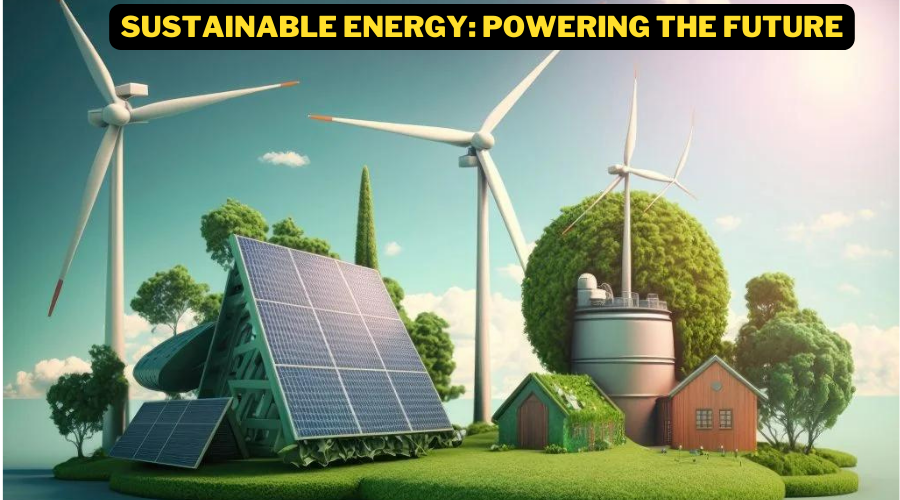Sustainable energy has emerged as a vital approach to the environmental challenges posed via traditional energy sources. As the world grapples with climate exchange and seeks ways to lessen carbon emissions, the transition to sustainable strength sources has won momentum. In this article, we discover the importance of sustainable energy, its diverse sources, benefits, challenges, international initiatives, technological improvements, and destiny traits.
| Category | Description |
|---|---|
| Sustainable Energy Sources | Renewable, low environmental impact |
| Importance | Combats climate change, energy security, economic growth |
| Examples | Solar, Wind, Hydropower, Geothermal |
| Transition Strategies | Renewable technology adoption, energy efficiency, policy & economic support |
| Future Outlook | Cost-effective, continuous advancements |
Introduction to Sustainable Energy
Defining Sustainable Energy


Sustainable strength refers to electricity assets which are renewable, environmentally friendly, and economically feasible over the long term. These electricity sources do not expend herbal sources or make a contribution to greenhouse fuel emissions, making them essential for mitigating climate alternate.
Importance of Sustainable Energy


The importance of sustainable energy can’t be overstated. By transitioning faraway from fossil fuels to renewable sources, we are able to reduce our carbon footprint, improve air quality, and guard the planet for future generations.
Types of Sustainable Energy Sources
Solar Energy
Solar energy harnesses the energy of the solar through photovoltaic panels or sun thermal structures. It is abundant, inexhaustible, and can be deployed on numerous scales, from rooftop installations to huge sun farms.
Wind Energy
Wind strength utilizes the kinetic power of wind to generate power. Wind generators, strategically located in windy areas onshore or offshore, convert wind electricity into a clean and renewable power supply.
Hydroelectric Power
Hydroelectric strength is based at the gravitational pressure of flowing or falling water to generate power. It is one of the oldest and most broadly used renewable power assets, with big-scale hydroelectric dams imparting enormous energy generation capability.
Geothermal Energy
Geothermal electricity taps into the warmth stored beneath the Earth’s surface. By harnessing steam or hot water from geothermal reservoirs, geothermal energy plants produce electricity and heat with minimum environmental impact.
Biomass Energy
Biomass electricity derives from natural substances along with timber, agricultural residues, and organic waste. Through processes like combustion, gasification, or anaerobic digestion, biomass can be converted into warmth, strength, or biofuels.
Advantages of Sustainable Energy
Environmental Benefits
One of the primary blessings of sustainable electricity is its minimum environmental effect. Unlike fossil fuels, renewable electricity assets produce little to no greenhouse gas emissions, helping to combat weather alternate and maintain ecosystems.
Economic Benefits
Investing in sustainable power can stimulate economic increase and create jobs in renewable power industries. Moreover, by way of decreasing dependence on imported fossil fuels, international locations can beautify strength security and stabilize strength costs.
Energy Security
Sustainable energy assets are inherently extra resilient and decentralized than conventional electricity assets. By diversifying the power blend and selling neighborhood energy manufacturing, international locations can beautify their power protection and reduce vulnerability to deliver disruptions.
Challenges of Sustainable Energy Adoption
Initial Costs
While the lengthy-term benefits of sustainable electricity are huge, the upfront expenses of renewable power installations may be prohibitive for a few consumers and groups. However, declining charges and government incentives are making renewable strength greater on hand and fee-effective.
Intermittency Issues
Certain renewable energy resources, which include solar and wind energy, are intermittent and dependent on weather situations. To deal with this project, improvements in power storage technology, grid control structures, and call for-side management are crucial.
Infrastructure Requirements
Expanding renewable electricity infrastructure calls for great investment in transmission strains, grid upgrades, and garage facilities. Policymakers must prioritize infrastructure improvement to assist the combination of sustainable electricity into existing electricity systems.
Global Initiatives and Policies
Paris Agreement
The Paris Agreement, adopted in 2015 via nearly 200 countries, ambitions to limit international warming to properly beneath 2 tiers Celsius above pre-commercial ranges. Signatories decide to decreasing greenhouse fuel emissions and enhancing resilience to climate alternate, with renewable strength playing a crucial role.
Renewable Energy Targets
Many nations have installed renewable power goals and incentives to accelerate the transition to sustainable power. These targets range in ambition and scope however usually involve increasing the share of renewable electricity in the ordinary strength mix.
Government Incentives
Governments international offer various incentives to sell renewable strength adoption, together with tax credits, feed-in tariffs, and presents for renewable strength projects. These incentives assist offset the preliminary expenses of funding and stimulate call for for sustainable power technologies.
Innovations in Sustainable Energy Technologies
Battery Storage Advancements
Advancements in battery garage era are revolutionizing the renewable strength vicinity by means of the usage of allowing electricity storage and grid stabilization. Lithium-ion batteries, waft batteries, and other storage solutions have become greater less costly and inexperienced, facilitating the mixture of sun and wind electricity into the grid.
Smart Grids
Smart grid generation optimize strength distribution and consumption with the aid of leveraging digital communique and control systems. By permitting actual-time tracking, demand response, and grid balancing, clever grids beautify performance, reliability, and resilience in energy structures.
Renewable Energy Integration
Innovative strategies to renewable energy integration, which incorporates hybrid renewable electricity systems and virtual power plants, are maximizing the value of sustainable electricity assets. By combining a couple of renewable strength assets and balancing deliver and call for dynamically, those answers enhance grid flexibility and balance.
Sustainable Energy in Developing Countries
Access to Clean Energy
Access to easy and occasional cost energy is crucial for achieving sustainable development dreams in growing international places. Off-grid renewable energy answers, which consist of solar lanterns and mini-grids, are expanding energy access and improving livelihoods in rural and a long way off regions.
Community Projects
Community-based absolutely renewable strength tasks empower nearby communities to take part in the electricity transition and benefit from easy power investments. These initiatives frequently contain collaborative possession models, shared choice-making, and socioeconomic development projects.
Microgrids
Microgrids are small-scale, localized energy structures that would carry out independently or at the facet of the precept grid. In regions with unreliable or nonexistent grid infrastructure, microgrids offer dependable strength get proper of entry to, resource monetary development, and beautify power resilience.
Role of Businesses in Sustainable Energy Transition
Corporate Sustainability Initiatives
Many groups are embracing sustainability as a center price and integrating renewable energy into their operations. Corporate sustainability duties, consisting of carbon neutrality pledges and renewable energy procurement commitments, are the usage of call for for easy energy and spurring innovation in the personal vicinity.
Investment in Renewable Energy Projects
Businesses are increasingly more making an funding in renewable strength projects to reduce their environmental footprint and hedge in opposition to future strength rate volatility. Through power purchase agreements, inexperienced bonds, and direct investments, organizations are helping the improvement of renewable energy infrastructure global.
Green Supply Chains
Sustainable deliver chain control includes reducing the environmental impact of sourcing, production, and distribution tactics. By prioritizing vendors with sustainable practices, optimizing transportation logistics, and minimizing waste era, organizations can make contributions to the transition to sustainable power.
Future Trends in Sustainable Energy
Increased Adoption of Electric Vehicles
The electrification of transportation is a key fashion the usage of call for for sustainable power. As electric powered cars turn out to be more less pricey and accessible, the demand for renewable electricity to energy them is anticipated to soar, similarly accelerating the transition a ways from fossil fuels.
Decentralization of Energy Systems
The decentralization of power systems, facilitated by way of dispensed technology era and peer-to-peer power buying and selling structures, is reshaping the energy landscape. By empowering clients to generate, save, and promote their very very own power, decentralization enhances strength autonomy, resilience, and sustainability.
Technological Advancements
Ongoing technological upgrades in renewable power, energy storage, and grid integration are driving down fees and improving performance. Innovations which include next-technology sun panels, advanced wind generators, and grid-scale power garage answers promise to make sustainable energy even extra on hand and green within the destiny.
Conclusion
Sustainable electricity holds the essential thing to a cleanser, extra wealthy future for our planet. By harnessing the electricity of renewable resources, we’re capable of fight climate alternate, beautify electricity protection, and create a greater sustainable worldwide for generations to return. It is vital that governments, agencies, and people alike prioritize the transition to sustainable energy and resource policies and obligations that boost up this crucial transition.
FAQs (Frequently Asked Questions)
What is sustainable power?
Sustainable strength refers to strength property which might be renewable, environmentally friendly, and economically possible over the long time.
Why is sustainable electricity essential?
Sustainable power is important because it allows reduce carbon emissions, mitigate climate alternate, and enhance strength protection.
What are a few examples of sustainable power belongings?
Examples of sustainable strength assets embody solar strength, wind energy, hydroelectric electricity, geothermal energy, and biomass energy.
What are the disturbing conditions of adopting sustainable electricity?
Challenges of adopting sustainable strength encompass initial prices, intermittency problems, and infrastructure necessities.
How can groups make a contribution to the transition to sustainable power?
Businesses can make a contribution to the transition to sustainable electricity by means of imposing employer sustainability projects, making an funding in renewable power obligations, and adopting green deliver chain practices.
What is sustainable power referred to as?
Sustainable energy is also called renewable electricity or green strength. It refers to strength assets which might be replenished truely and are environmentally best.
What is an example of sustainable electricity?
Examples of sustainable energy encompass solar energy, wind electricity, hydropower, geothermal electricity, and biomass energy.
Why is sustainable strength essential?
Sustainable power is essential for lowering carbon emissions, stopping weather change, selling strength safety, and fostering monetary development thru the usage of smooth and inexhaustible sources.
What are the three ideas of sustainable energy?
The 3 ideas of sustainable power are strength overall performance, environmental friendliness, and social equity.
What are the fundamentals of sustainable energy?
The fundamentals of sustainable power include harnessing power from natural assets together with daytime, wind, water, and warmth from the earth’s crust, at the same time as minimizing environmental impact and promoting long-time period viability.
What is the difference among renewable energy and sustainable power?
Renewable strength refers especially to strength resources which are actually replenished, at the same time as sustainable power encompasses not only renewable belongings but additionally focuses on the lengthy-time period viability and environmental impact of strength production and intake.
What is the superb kind of sustainable power?
The fine kind of sustainable energy relies upon on different factors together with geographical location, useful resource availability, and technological improvements. Generally, sun and wind power are taken into consideration maximum of the maximum promising and substantially adopted varieties of sustainable electricity.
What is the most famous definition of sustainable electricity?
The most well-known definition of sustainable strength refers to electricity derived from property that can be replenished evidently, which include sun, wind, hydro, and geothermal power, without depleting finite resources or inflicting harm to the environment.
What are the 5 sources of electricity?
The 5 resources of strength are fossil fuels (coal, oil, herbal fuel), nuclear power, renewable energy (solar, wind, hydro, geothermal, biomass), and possibility strength sources along side tidal and wave power.
Which SDG is power?
Sustainable Development Goal 7 (SDG 7) specializes in ensuring get proper of entry to to low-value, reliable, sustainable, and contemporary power for all.
Is Solar Energy Green?
Yes, sun energy is considered green because it generates energy using sunlight hours, a renewable and clean source of power, with out emitting greenhouse gases or pollutants.
What is the future for renewable energy?
The destiny for renewable strength looks promising, with upgrades in technology, decreasing fees, and developing worldwide popularity of climate exchange riding elevated adoption and investment in renewable strength resources.
What is the destiny of the power industry?
The destiny of the energy enterprise is expected to go through big transformation inside the direction of renewable and sustainable sources, decentralized power systems, increased electricity performance, and digitalization.
What are the four major varieties of sustainable energy?
The four foremost forms of sustainable power are solar power, wind strength, hydroelectric electricity, and biomass strength.
What is the future power?
The future of strength might be to be characterized through the use of a shift toward cleanser, renewable sources, extra strength performance, decentralized power manufacturing, and innovative generation to satisfy growing energy wishes sustainably.
What is the destiny of energy in 2030?
By 2030, the strength panorama is expected to be appreciably precipitated via renewable electricity expansion, strength garage enhancements, electrification of transportation, smart grid generation, and extended awareness on power efficiency to mitigate climate alternate and ensure strength safety.
What is the destiny of energy overall performance?
The future of energy efficiency includes imposing measures to reduce power intake via technological innovations, building retrofits, efficient transportation systems, and behavioral adjustments, thereby decreasing carbon emissions and enhancing sustainability.
What is the first-class future power source?
The tremendous destiny power supply is probably to be a mixture of renewable strength era which includes solar, wind, and hydro, alongside side improvements in electricity garage, smart grid systems, and electricity performance measures to make sure reliability, affordability, and sustainability.
What is a sustainable strength opportunity?
A sustainable power opportunity refers to an electricity deliver or era that offers an environmentally pleasant and socially equitable answer to conventional fossil fuels, in conjunction with renewable strength resources like solar, wind, and biomass, or modern technologies like hydrogen fuel cells.
What are five advantages of renewable electricity?
Five advantages of renewable energy consist of reduced greenhouse fuel emissions, progressed air brilliant, power protection, challenge introduction, and financial growth via investments in smooth energy technology and infrastructure.


TotalInfo4U: Your Ultimate Source for Comprehensive Knowledge

